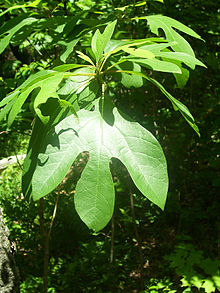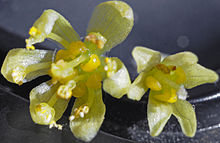 |
|
|
|
|
| Cuisines | Herbal | Spice | Curry | Yeast | Recipe | ||||||
|
Sassafras Sassafras is a genus of three extant and one extinct species of deciduous trees in the family Lauraceae, native to eastern North America and eastern Asia. Sassafras trees grow from 9–18 m (30–59 ft) tall and spreading 7.5–12 m (25–39 ft). The trunk grows 70–150 cm (28–59 in) in diameter, with many slender branches, and smooth, orange-brown bark. The branching is sympodial. The bark of the mature trunk is thick, red-brown, and deeply furrowed. The wood is light, hard, and sometimes brittle. All parts of the plants are very fragrant. The species are unusual in having three distinct leaf patterns on the same plant, unlobed oval, bilobed (mitten-shaped), and trilobed (three-pronged); rarely the leaves can be five-lobed. They have smooth margins and grow 7–20 cm long by 5–10 cm broad. The young leaves and twigs are quite mucilaginous, and produce a citrus-like scent when crushed. The tiny, yellow flowers are five-petaled, and bloom in the spring; they are dioecious, with male and female flowers on separate trees. The fruit are blue-black, egg-shaped, 1 cm long, produced on long, red-stalked cups, and mature in late summer. The largest sassafras tree in the United States is located in Owensboro, Kentucky, which measures over 100 feet high and 21 feet in circumference. The name "sassafras," applied by the botanist Nicolas Monardes in the 16th century, is said to be a corruption of the Spanish word for saxifrage. Uses Steam distillation of dried root bark produces an essential oil consisting mostly of safrole that once was extensively used as a fragrance in perfumes and soaps, food and for aromatherapy. The yield of this oil from American sassafras is quite low, and great effort is needed to produce useful amounts of the root bark. Sassafras extract was a primary ingredient in root beer. Commercial "sassafras oil" generally is a byproduct of camphor production in Asia or comes from related trees in Brazil. Safrole is a precursor for the clandestine manufacture of the drug MDMA (ecstasy), as well as the drug MDA (3-4 methylenedioxyamphetamine) and as such, its transport is monitored internationally. Culinary uses The roots of sassafras can be steeped to make tea, and were used in the flavoring of traditional root beer until being banned for mass production by the FDA. Laboratory animals that were given oral doses of sassafras tea or sassafras oil that contained large doses of safrole developed permanent liver damage or various types of cancer. In humans, liver damage can take years to develop and it may not have obvious signs. Along with commercially available sarsaparilla, sassafras remains an ingredient in use among hobby or microbrew enthusiasts. In 1960, the FDA banned the use of sassafras oil and safrole in commercially mass-produced foods and drugs based on the animal studies and human case reports. Several years later, sassafras tea was banned, a ban that lasted until the passage of the Dietary Supplement Health and Education Act in 1994. Sassafras root extracts which do not contain safrole or in which the safrole has been removed are permissible, and are still widely used commercially in teas and root beers. Sassafras tea can also be used as an anticoagulant. Filé powder, also called gumbo filé, for its use in making gumbo, is a spicy herb made from the dried and ground leaves of the sassafras tree. |











